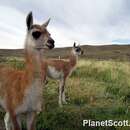en
names in breadcrumbs


Guanacos when young are vulnerable to pumas, but the reduction in the puma populations has lead to mortality due to starvation.
Adult guanacos can run at speeds of up to 56km/hr.
Perception Channels: tactile ; chemical
Guanacos have had their numbers drastically reduced due to human pressures of habitat encroachment, habitat destruction, and hunting. In addition, climatic changes are also blamed for decreases in population size and range.
IUCN Red List of Threatened Species: least concern
Guanacos have long been hunted for their meat and fur. They are believed to be the ancestor to the now domesticated llamas and alpacas, which are important as beasts of burden and for their fur.
Guanacos are herbivores that can inhabit dry areas and forego drinking for long periods. They are versatile foragers, both browsing and grazing on grasses and plants.
Found from southern Peru down the Andean zone of Chile and Argentina to Tierra del Fuego and Navarino Island. There is also a population in far western Paraguay.
Biogeographic Regions: neotropical (Native )
Guanacos inhabit grasslands and shrublands from sea level to 4,000m. Occasionally they winter in forests.
Terrestrial Biomes: desert or dune ; savanna or grassland ; mountains
Average lifespan
Status: captivity: 28.3 years.
Average lifespan
Status: wild: 20.0 years.
They stand at 1,100 to 1,200mm at the shoulder and have slender bodies with long limbs and neck. The head is typical of camelids with long, pointed ears and cleft, highly mobile lips. Their fur can be long, thick and wooly, especially along the flanks, chest and thighs. It is reddish-brown dorsally, and the underparts are white.
Range mass: 115 to 140 kg.
Other Physical Features: endothermic ; bilateral symmetry
Females are apparently induced ovulators, and especially in the southern end of the range breeding reaches a peak in February. Young are born in December to February after an eleven month gestation period. They weigh 8-15kg at birth and nurse for eleven to fifteen months. Females may begin to breed as early as one year of age, sometimes younger, though two to three years old is more typical.
Key Reproductive Features: gonochoric/gonochoristic/dioecious (sexes separate); sexual
Average birth mass: 11500 g.
Average gestation period: 335 days.
Average number of offspring: 1.
Average age at sexual or reproductive maturity (male)
Sex: male: 730 days.
Average age at sexual or reproductive maturity (female)
Sex: female: 365 days.